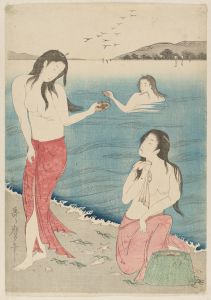
This is the only print in Worcester City’s small Japanese print collection that does not have a definite artist attribution. It has no publisher’s seal or censor stamp, so it cannot be dated with any certainty. It does, however, have a signature – Utamaro.
Kitagawa Utamaro I (1753-1806) was one of the greatest masters of ukiyo-e. He produced a number of prints like this one, picturing diving-women, some with a near-identical composition to this one. However this print does not seem to have the quality of his work, and its general style and use of colour are not those of an 18th century print.
Utamaro had a pupil, Koikawa Shuncho, who worked with him and possibly contributed to his work at the end of his career when his health was failing. On his master’s death, Koikawa Shuncho married his widow, took over his name, and continued to make Utamaro prints using the same carved signature as his master, so that it is hard at times to be certain whether a print is by Utamaro I or Utamaro II. The likelihood is that this one is by Utamaro II, who continued to use that name until 1820, when he changed it again to Kitagawa Tetsugoro.
The subject of this print is three awabe-tori – women who dive for abalones, which were (and still are) a much-prized delicacy. Diving for shellfish was a tradition in Japanese coastal villages, and it was always done by women, who developed astonishing powers of breath-control. The tradition is continued by a few women, mostly elderly, in some remote parts of Japan today. Of course, the erotic potential of showing bare-breasted women at a time when most Japanese women revealed very little flesh explains the popularity of the subject.